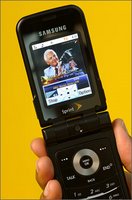 Check out TI's Mobile TV page, and you'll see that live TV programming is making its way to a mobile phone near you. The technology is driven by Hollywood™ Solution's DTV100x chips, single pieces of silicon that combine both TV tuner and demodulator.
Check out TI's Mobile TV page, and you'll see that live TV programming is making its way to a mobile phone near you. The technology is driven by Hollywood™ Solution's DTV100x chips, single pieces of silicon that combine both TV tuner and demodulator.
A new infrastructure will be needed to push TV programming to cell phones. But where new technology is required, features abound. Subscribers will be able to access not only live (passive) TV, but PPV programming, new interactive TV programming, and even digital radio services -- note to self, sell SIRI and XMSR now. Perhaps suprising are features that require more real estate on the screen or hard drive. I can't imagine picture-in-picture (PIP) on a thumb-sized LCD. That is, without reading glasses twice as thick as my phone. And digital video recording (DVR) has been micro-sized and personalized with the moniker personal video recording, or PVR.
PVR is a form of DVR where Monday Night Football doesn't have to compete with Disney programming for fixed storage space.
I wonder if PVR is more than any sane person would want. When our single, trusty 19" TV went on the blink we were hard pressed to find a new television that was smaller than our refrigerator. You may ask, if one is going to the trouble to record a program, why not wait until one returns to the comfort of their home theater to watch it, sans reading glasses?
I suppose if one has merely a single home theatre, which is dedicated to Disney programming, the PVR might help one catch up on Monday Night Football during a slow moment on Tuesday.
Q: Will you PVR for the road, or watch it at home?
Photo: Texas Instruments. Trademarks are property of their holders.
Friday, October 06, 2006
Personal Video Recording (PVR) Goes Mobile With Technology From Texas Instruments
Posted by
James D. McNamara, PMP
at
6:00 PM
0
comments
![]()
Friday, September 15, 2006
Real-time Digital Marketplace for Parking Spaces
 I knew parking spaces were precious. Now we have to compete with the alpha digerati to find them. Tele Atlas and SpotScout are collaborating to...
I knew parking spaces were precious. Now we have to compete with the alpha digerati to find them. Tele Atlas and SpotScout are collaborating to......help drivers find information about available parking spaces via a mobile information network. Combined with Tele Atlas’ highly accurate and up-to-date digital maps, subscribing mobile navigation system users will be able to quickly “spotscout” for and reserve a parking space that a “spotscaster” near them owns, leases or plans to vacate.
Finding the negotiated parking space should be easy, since Tele Atlas has recently announced it will be the data provider for the TomTom ONE in North America.
Q. Have you used any mobile, location-based services recently?
Posted by
James D. McNamara, PMP
at
8:00 AM
0
comments
![]()
Labels: LBS, SpotScout, Tele Atlas, TomTom
Friday, September 01, 2006
Will consumers tune in to a tiny TV in their hand?
 Edward C. Baig, USA TODAY, reported about customers' perspectives on the phenom of TV viewed over mobile devices. It showcases MobiTV by Sprint. Although Sprint launched MobiTV in 2003, the advent of 3G speeds made it work at acceptable speeds.
Edward C. Baig, USA TODAY, reported about customers' perspectives on the phenom of TV viewed over mobile devices. It showcases MobiTV by Sprint. Although Sprint launched MobiTV in 2003, the advent of 3G speeds made it work at acceptable speeds.
IDC predicts use will grow from 7 million in 2006 to 24 million users in 2010, or 9.2% of U.S. cellular subscribers. This will drive a demand from content, especially that which can fit into small timeslices on equally small screens. As we've seen with YouTube and its look-alikes, no doubt a lot of this content will be home-brewed. Vodcast overtakes podcast.
I particularly enjoyed Stephen Froehlich's, IMS Research, breakdown of viewers into three categories:
"Snackers" spend three to five minutes watching stand-up comedy clips, sports highlights and so on. "Commuters" (or lunchtime viewers) will devote 20 to 30 minutes to watch sitcoms, dramas or news. And then there are "background noise viewers," who actually use mobile TVs at home.Q. Are you a snacker, commuter, or background-noise viewer?
Photo: by Leslie Smith, Jr., USA TODAY
Posted by
James D. McNamara, PMP
at
11:00 PM
0
comments
![]()
Labels: Sprint Nextel, tv, vodcast